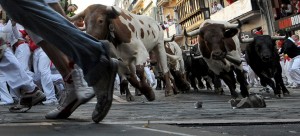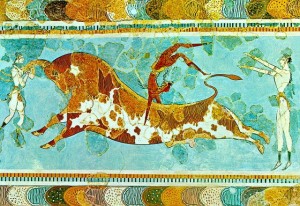A Rumble of Hooves in Spanish Pictdom
Wednesday, July 8, 2009
posted by Deuce Richardson
 Print This Post
Print This Post
“Bullfighting is indeed a reversion to Roman amphitheater days. I have an idea that the Mediterranean peoples have practiced it in some form or other every since the days of Crete, where it flourished, according to vases and the like.”
Robert E. Howard to HP Lovecraft, ca. January 1931

The bulls are running again in Pamplona, once the heart of medieval Vasconia, and what is now known as the Basque Country. The Feast of St. Fermin is an ancient one, with records attesting the encierro going back at least eight centuries. There are some indications that its roots extend much further.
Robert E. Howard left no doubt as to whom he felt the Eskualdunak (as the Basques call themselves in Europe’s oldest known native language) were most akin to: the Picts. In “The Lost Race,” REH stated that the British Picts left kindred behind in the Pyrenees to “stay any who might follow.” In “Worms of the Earth,” Bran Mak Morn recalls tales of his Basque brethren, regarding them with slight disdain for paying scot to the pre-Milesian Gaels. Geneticists such as Sykes and Oppenheimer have vindicated Howard’s gut instincts regarding the kinship betwixt the most ancient peoples of Iberia and the British Isles.
The historical Basques have little to be ashamed of. They managed to maintain a limited sovereignty (and their native language) during Roman Imperial times. After the fall of the Empire, they quickly reasserted their independence; an independence they would never quite relinquish for a millenium, defying Visigoth, Moor, Frank and Castillian. It was Basques, not Saracens, who laid the peerless Roland low at Roncesvalles. The Basque town of Bilbao became synonymous with fine steel. Bilbo Baggins owes his name, ultimately, to the land and language of the Vascones. The hard-bitten St. Ignatius Loyola and St. Francis Xavier were both Basques. It was a Basque who captained Magellan’s ship back to Spain.
 Pamplona itself is, of course, world-famous from Papa Hemingway’s The Sun Also Rises (1926). Here is how Ernest describes the northern approach to that ancient town:
Pamplona itself is, of course, world-famous from Papa Hemingway’s The Sun Also Rises (1926). Here is how Ernest describes the northern approach to that ancient town:
Then we crossed a wide plain, and there was a big river off on the right shining in the sun from between the line of trees, and away off you could see the plateau of Pamplona rising out of the plain, and the walls of the city, and the great brown cathedral, and the broken skyline of the other churches. In back of the plateau were the mountains, and every way you looked there were other mountains, and ahead the road stretched out white across the plain going toward Pamplona.
Hemingway limns the encierro and its attendant taurine fury as well as anyone I’ve read. This passage has probably impelled more turistas toward Pamplona than any other half-page of prose in the last thousand years:
I leaned way over the wall and tried to see into the cage. It was dark. Someone rapped on the cage with an iron bar. Inside something seemed to explode. The bull, striking into the wood from side to side with his horns, made a great noise. Then I saw a dark muzzle and the shadow of horns, and then, with a clattering on the wood in the hollow box, the bull charged and came out into the corral, skidding with his forefeet in the straw as he stopped, his head up, the great hump of muscle on his neck swollen tight, his body muscles quivering as he looked up at the crowd on the stone walls. The two steers backed away against the wall, their heads sunken, their eyes watching the bull.
The bull saw them and charged. A man shouted from behind one of the boxes and slapped his hat against the planks, and the bull, before he reached the steer, turned, gathered himself and charged where the man had been, trying to reach him behind the planks with a half-dozen quick, searching drives with the right horn.
A scene comparable, in its way, to that of the ‘dragon on the mount’ in “Red Nails.”
Some historians and archaeologists have postulated that the bull-fighting culture of the Iberian Peninsula somehow owes its existence to Mithraic rituals dating from the Imperial Roman period. Perhaps.
Robert E. Howard proposed an older, darker lineage for the archetypical Hispanic sport, linking it to Minos and pre-Mykenaean Crete. He surmised that “bull games” were endemic to the “Mediterranean” peoples. Anyone who has read Bran Mak Morn: The Last King cover-to-cover knows that Howard envisioned the Picts as being the “root race” of the Mediterranean peoples.
Patrice Louinet has speculated that Robert E. Howard read some of the works of Lewis Spence; namely, The Problem of Atlantis and Atlantis in America. Having read both myself, I must agree. Spence’s descriptions of the Neolithic “Azilians-Tardenoisians” bear such an uncanny resemblance to how REH portrayed his “Mediterranean/Iberian” Picts that mere coincidence is unlikely. Spence linked the Azilians (the name is derived from a locality in the Basque Country) to Atlantis. REH linked his Picts directly to Atlantis (for the first and last time) in “Men of the Shadows.”

Spence, following the lead of Plato, attributed “bull games” and bull-worship to the Neolithic Iberians, as well as their (supposed) Atlantean forebears. It is but a short (bull-) leap to Knossos from there. It is hard to see how REH would not have made the same inference. I wonder what both authors (equally avid aficionados of mankind’s murky past) would have made of bull-horn bedecked Catal Höyük?

All of this brings us full-circle back to St. Fermin and the British Picts. There are four sites in England seemingly connected with St. Fermin (who is the co-patron saint of the Basque region of Navarre, along with St. Francis Xavier). Pre-Christian deities sometimes lurk behind saintly facades. The Picts, according to Robert E. Howard, once ruled all of Britain, including the green and pleasant land now known as England. Might “Fermin” (or something similar) be the name of a “Pictish” deity (perhaps associated with bulls) once venerated from the Pyrenees to the Grampians?
Yea or nay, the bulls of Pamplona still demand their pound of flesh and blood before they die. Four men have been injured by bulls in the cobbled streets of that ancient town so far this week.

